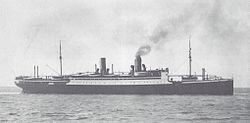Stuttgart (ship, 1924)
|
Stuttgart
|
||||||||||||||||||
|
||||||||||||||||||
|
||||||||||||||||||
|
||||||||||||||||||
|
||||||||||||||||||
The Stuttgart was a passenger steamship of the North German Lloyd . In 1938 the ship was bought by the German Labor Front . Used during the war as a hospital ship, the Stuttgart was badly hit in an American air raid on Gotenhafen in October 1943 .
history
The Stuttgart was built from 1923 by the Vulkan Werft Stettin as a sister ship of the Munich for the North German Lloyd. It was launched in Stettin on July 31, 1923 and began its maiden voyage to New York on January 15, 1924 . With her sister, the Stuttgart was used in transatlantic traffic with three passenger classes. It offered space for 1,105 passengers. From 1926 the ship was also used for cruises. At the beginning of 1928 their passenger facilities were also changed and the number of higher-quality seats increased (969 to 1015 passengers). In November 1927, the Stuttgart first called Halifax in Canada on a transatlantic voyage . During her travels in the 1930s, the Stuttgart ran regularly to Ireland and Halifax in Canada until July 1937. In 1933/34 it was used in Bremerhaven as a vocational school for seafarers. From 1934 she also ran cruises again and ran out in December for her last scheduled service for the NDL and for her first trip to East Asia.
After that only cruises followed and on September 1, 1938 the ship was sold to the German Labor Front ; The NDL continued to manage the Stuttgart, which had been converted into a single-class ship for 990 passengers . In May 1939 she ran with the KdF fleet ( Robert Ley , Der Deutsche , Wilhelm Gustloff and Sierra Cordoba ) and the Oceana to Vigo to transport the Condor Legion back to Germany. Almost 800 German soldiers returned on the Stuttgart .
On August 23, 1939, the Navy took over the Stuttgart as a hospital ship . In April / May 1940 the ship was in Oslo for three weeks . In the spring of 1941, the Stuttgart moved again to Norway and was stationed there in Kirkenes and Tromsö . On October 9, 1943, shortly before she was about to leave for Norway again, she was badly hit in an American air raid in Gotenhafen. The burning wreck was towed onto the Baltic Sea and sunk. 48 people died in the attack.
In 1999 Benedykt Hac came across the remains of the Stuttgart during a routine examination of the bottom of the Danzig Bay . The remaining fuel from the wreck represents a major threat to the environment in Gdańsk Bay today.
literature
- Arnold Kludas : The History of German Passenger Shipping 1850 to 1990 . Ernst Kabel Verlag, 1986.
- Arnold Kludas: The ships of the North German Lloyd 1920 to 1970 . Koehlers Verlagsgesellschaft, 1992, ISBN 3-7822-0534-0 .
- Claus Rothe: German ocean passenger ships 1919 to 1985 . Steiger Verlag, 1987, ISBN 3-921564-97-2 .
- Reinhart Schmelzkopf: The German Merchant Shipping 1919–1939 . Verlag Gerhard Stalling, Oldenburg, ISBN 3-7979-1847-X .
Web links
Footnotes
- ^ Image of the Munich
- ↑ a b Kludas: Seeschiffe des NDL, p. 24
- ↑ image of the Stuttgart
- ↑ Bremen passenger lists
- ↑ sueddeutsche.de July 1, 2017: A foul-smelling, black, pulpy mass that contains more tar-like heavy oil than sand
Coordinates: 54 ° 41 ′ 0 ″ N , 16 ° 51 ′ 0 ″ E

